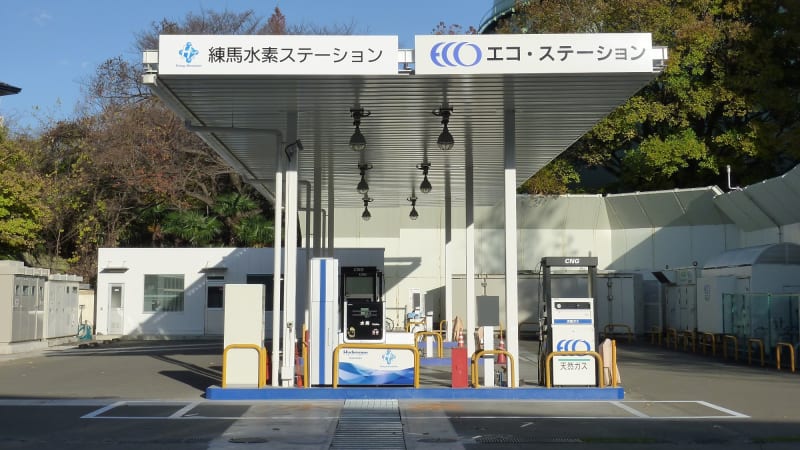Japanese automakers will seriously subsidize hydrogen fuel stations

The partnership, which is called the Joint Hydrogen Infrastructure Support Project, is subsidizing a third of the annual operating expenses up to a maximum of 11 million yen ($90,000) for any hydrogen refueling station that applies and is accepted into the program. For now, the automakers plan to keep this running through around 2020. Toyota senior managing officer Kiyotaka Ise tells Bloomberg the whole thing over that time is expected to cost 5 billion to 6 billion yen ($40.5 million to $49 million). In addition to the money, the companies are trying to raise awareness about the alternative fuel to build popularity.
Japan has been pushing extremely hard to build the FCV market there for quite some time by subsidizing both the models and building refueling stations for them. By the 2020 Olympics, the country's goal is to have 6,000 fuel cell vehicles on the roads and possibly even 100,000 of them by 2025. The cars to fulfill these lofty hopes are just gaining steam, though. For example, the Mirai is already experiencing high demand, and Honda is set to bring its new challenger in 2016. This announcement says Nissan is aiming a potential entry for 2017, as well. According to Bloomberg, the fuel cell industry in Japan is forecasted to balloon from 400 million yen (3.3 million) in the current fiscal year to 100 billion ($813 million) by 2025. Show full PR text Toyota, Nissan, and Honda Agree on Details of Joint Support for Hydrogen Infrastructure Development
Toyota Motor Corporation, Nissan Motor Co., Ltd., and Honda Motor Co., Ltd. have agreed on key details regarding a new joint support project for the development of hydrogen station infrastructure in Japan. In addition to partially covering the operating costs of hydrogen stations, the three automakers have also agreed to help infrastructure companies deliver the best possible customer service and create a convenient, hassle-free refueling network for owners of fuel cell vehicles (FCVs).
The joint project (conducted alongside the Japanese government's support for hydrogen stations) will partially cover hydrogen station operating expenses incurred by infrastructure companies, and was first announced on February 12. Furthermore project partners will jointly raise awareness regarding these support measures, in order to encourage new companies to enter the hydrogen supply business. Financial assistance will be provided through the Research Association of Hydrogen Supply/Utilization Technology* (HySUT), which is setting up a project to stimulate demand for FCVs.
Summary of Joint Hydrogen Infrastructure Support Project
Recipients of support -
HySUT members
Scope of support -
Covering operational expenses (personnel, refurbishment, etc.) for hydrogen stations selected through the Next Generation Vehicle Promotion Center (NeV) 's new project to support activities aiming to stimulate demand for FCVs
One third of the expenses defined by the NeV Project; annual support limit of 11 million yen per station
Note amount may be reassessed in some cases in accordance with governmental measures and the construction/operational status of hydrogen stations
Applications open -
July 1, 2015 (for current fiscal year)
Note for next fiscal year and beyond, separate applications will be required
Note -
If the period eligible for NeV support starts before July 1, the subsidy will be paid retroactively.
Furthermore, to help popularize FCVs by creating a reliable hydrogen fueling environment and ensuring peace of mind for FCV owners, the three automakers will work with infrastructure companies to take the following steps:
Using information such as customer needs and hydrogen station operating rates to improve customer service levels
Improving the convenience of hydrogen stations by increasing the number of days they are open, extending their business hours, enhancing and providing operational information, and developing hydrogen station infrastructure that is easy to access
Raising public awareness about FCVs and hydrogen
Background
For FCVs to gain popularity, creating attractive products is only half of the equation. Hydrogen station infrastructure must also be developed to ensure ease-of-use for customers; however, infrastructure companies face difficulties constructing and operating hydrogen stations. FCVs are a new entry into the market, and hydrogen station revenues are expected to remain low due to the limited number of cars currently on the road.
In June 2014, the Japanese government unveiled its Strategic Road Map for Hydrogen and Fuel Cells, which involves subsidizing the construction of hydrogen stations and reviewing regulations. Furthermore, in February, the Japanese government decided to partially subsidize hydrogen station operational expenses in order to help stimulate new demand for FCVs. In such ways, the Japanese government continues to contribute to the development of hydrogen station infrastructure.
Meanwhile, Toyota launched the Mirai FCV in late 2014, while Honda has announced its plan to bring an FCV to market before April 2016 and Nissan is also planning to market an FCV as early as 2017.
Through this project, the three automakers plan to steadily support hydrogen station infrastructure from a medium-term perspective, until FCVs become well established in the market and the development of hydrogen station infrastructure is well underway (potentially around 2020).
*Established in July 2009 based on the Act on Research and Development Partnership concerning Mining and Manufacturing Technology, with the goal of building hydrogen supply infrastructure and developing a business environment conducive to widespread use of FCVs by 2015. There are currently 19 member companies/organizations, including energy infrastructure companies as well as automakers. Source






